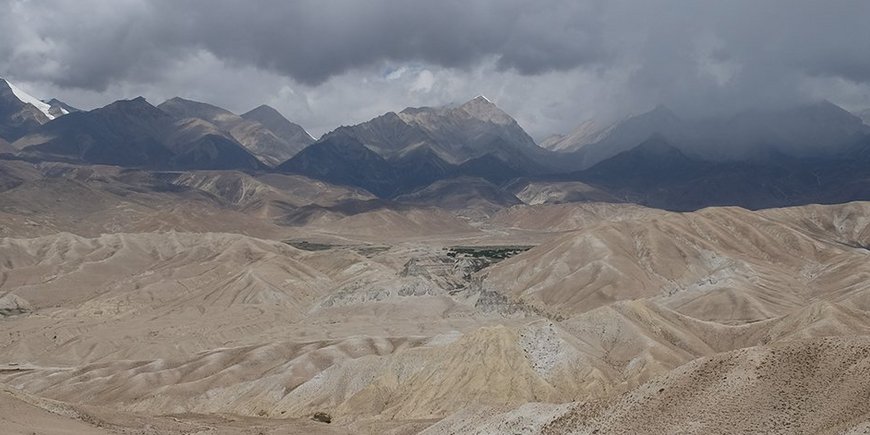Some environmental changes are gradual and can be reversed, for example, by nature conservation measures. However, there are also changes in habitats that are irreversible. Particularly in arid areas, dying off the already sparse vegetation can lead to deserts forming or the soil being lost in one rare heavy rainfall event. An international team of researchers led by Johanna Menges, PhD student in GFZ section Geomorphology, has now identified such a "tipping point" in the old kingdom of Mustang in the Himalayas.
Until two thousand years ago, for example, the soils in the Kali Gandaki Valley in Nepal were intact for about 5000 years, despite colonisation. Then the pressure from human cultivation increased, deforestation and overgrazing occurred. When a prolonged drought occurred 1600 years ago, the ecosystem was overturned: plants dried up, water tore deep ditches into the landscape and the soil washed away. Badlands, which are still desert today, were quickly formed. The researchers report on this in the journal Geophysical Research Letters.
Worldwide, around two billion people live in arid regions. Small changes in climate or land use can have major impacts on soil stability and food security. In the case of the highlands in Nepal, there was a 20 percent reduction in humidity and a decline in precipitation to less than 200 millimeters per year. This was preceded by the use of the barren areas by logging and livestock farming. Today about half of the highlands in the Kali Gandaki catchment area consist of "badlands" or degraded soils.
For their analysis, the researchers compared today's erosion rates with the earlier phase of soil formation. For this purpose, they investigated sediment in the lower reaches of rivers from the highlands and examined biomarkers, molecular fossils of plants, in the remains of the soils, which recorded the changes in precipitation.
The researchers conclude that the loss of soil and vegetation is irreversible. For the study area, they determined the tipping point at 200 millimetres of precipitation per year. According to the researchers, other dry regions could also have such threshold values, although the exact value could vary depending on local conditions. "It is important that there is no way back to intact soils in the near future after tipping," says Johanna Menges, even if it rains a little more. (jz)
Original study: Menges, J., Hovius, N., Andermann, C., et al., 2019. Late Holocene Landscape Collapse of a Trans-Himalayan Dryland: Human Impact and Aridification. Geophysical Research Letters. DOI: 10.1029/2019GL084192








![[Translate to English:] Torsten Sachs in front of a climate station on a field](/fileadmin/_processed_/3/9/csm__TorstenSachs_bearbeitet_GS_4a1365ef84.jpeg)

![[Translate to English:] left image flood at the Ahrtal: image from above, several houses are flooded; left image:: Heidi Kreibich;](/fileadmin/_processed_/4/4/csm_Bild2_9af0130e9f.png)



![[Translate to English:] Start der Vega Rakete](/fileadmin/_processed_/6/4/csm_20231201-kachel_Vega-VV23-launch_ESA-CNES-Arianespace_706716b68c.jpeg)









![[Translate to English:] Poster exhibition at the Brandenburg Hydrogen Day at the GFZ, some participants in the foreground](/fileadmin/_processed_/6/5/csm_Erster_Brandenburgischer_Wasserstofftag_GFZ_402fcec95e.jpeg)
![[Translate to English:] Group picture of the participants](/fileadmin/_processed_/9/4/csm_20231108_CAWa-Workshop-Tashkent_Gruppenbild_99ea779d8a.jpeg)

![[Translate to English:] [Translate to English:] Hörsaal](/fileadmin/_processed_/e/6/csm_H%C3%B6rsal_e21ac645fb.jpeg)


![[Translate to English:] The Delegations in the Historic Library on the Telegrafenberg. In the back there are from left to right, the Dutch Ambassador for Germany, Ronald van Roeden, the Dutch Minister for Education, Culture and Science, Robbert Dijkgraaf and the scientific director of the GFZ, Susanne Buiter.](/fileadmin/_processed_/d/b/csm_Kachel-2_9eba4b4212.jpeg)

